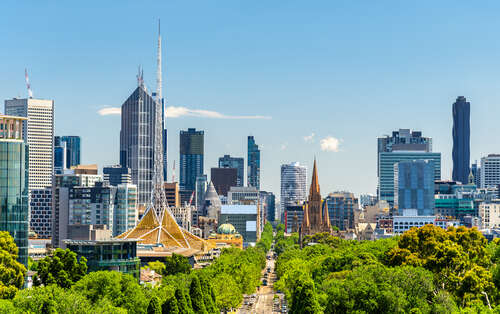
Australia’s urban landscape is a tapestry of culture, diversity and economic strength. As the nation continues to evolve, its cities play a vital role in shaping its future. But which are the largest cities in Australia?

We will explore Australia’s most populous cities based on recent figures and the Australian Bureau of Statistics Census, providing an in-depth look into their unique characteristics, the latest available GDP figures and their efforts towards achieving net-zero emissions goals.
Sydney, New South Wales
Population: 4.8 million
Net-zero target: 2035
Sydney, Australia’s largest and perhaps most iconic city, is renowned for its harbour, cultural landmarks and burgeoning economy. It serves as a global hub for finance, technology and tourism. Sydney’s Central Business District (CBD) hosts a concentration of multinational corporations, while its tech precincts and start-up culture contribute to its economic vitality.
Melbourne, Victoria
Population: Approximately 4.7 million
Net-zero target: 2040
Melbourne, the cultural capital of Australia, boasts a vibrant arts scene, diverse culinary experiences, and a strong presence in the finance, education and healthcare sectors. Its cultural diversity and notable events calendar have earned it the ‘World’s Most Livable City‘ accolades in the past, from 2011 to 2017, in fact.
Brisbane, Queensland
Population: Approximately 3.03 million
Net-zero target: 2050
Brisbane, known as the Sunshine State’s gem, offers a pleasant climate, scenic river, and a growing economy fueled by mining, construction and education. As a city committed to sustainability, Brisbane has set a goal to achieve net-zero emissions by 2050, aligning itself with Australia’s national efforts to combat climate change.
Perth, Western Australia
Population: Approximately 2.1 million
Net-zero target: 2050
Perth, located on Australia’s west coast, is synonymous with beaches and a robust mining industry. It’s also emerging as a tech and start-up hub. With a commitment to environmental stewardship, Perth emphasises its role in addressing climate change and embracing a sustainable future.
Adelaide, South Australia
Population: Approximately 1.27 million
Net-zero target: 2030
Adelaide, known for its wine regions and cultural festivals, has a strong presence in defence, manufacturing and healthcare industries. As part of Australia’s efforts to combat climate change, Adelaide has set a goal to achieve net-zero emissions by 2050, demonstrating its commitment to environmental responsibility.
Central Coast, New South Wales
Population: Approximately 346,000
Net-zero target: 2050
The Central Coast is known for its coastal lifestyle and growth in the construction, tourism, and healthcare sectors. Embracing a sustainable future, the Central Coast aims to achieve net-zero emissions by 2050, contributing to New South Wales’ broader environmental goals.
Hobart, Tasmania
Population: 247:000
Net-zero target: 2030
Hobart is the capital city of the Australian state of Tasmania. It is the largest city in Tasmania and serves as its administrative and economic centre. It has a rich history dating back to its origins as a British penal colony in 1804. It’s known for its picturesque waterfront, cultural attractions, diverse economy, and outdoor activities like hiking on Mount Wellington.
Wollongong, New South Wales
Population: Approximately 214,000
Net-zero target: 2030
Wollongong, situated along the coast, is characterised by its strong manufacturing, healthcare and education industries. With an ambitious target of achieving net-zero emissions by 2030, Wollongong is at the forefront of climate action, highlighting its commitment to environmental sustainability.
Newcastle, New South Wales
Population: Approximately 168,000
Net-zero target: 2050
Newcastle, a major regional centre, is known for its coal exports and expanding healthcare and education sectors. In alignment with Australia’s national efforts to address climate change, Newcastle has set a target to achieve net-zero emissions by 2050, emphasising its commitment to sustainability and a cleaner future.
Canberra, Australian Capital Territory
Population: Approximately 145,000
Net-zero target: 2045
Canberra, Australia’s capital, hosts the nation’s political and administrative heart. It thrives on government services and the education sector. In a significant move towards sustainability, Canberra has set an ambitious goal of achieving net-zero emissions by 2045, reflecting its commitment to leading by example.
As they strive towards their net-zero emissions goals, the largest cities in Australia are not only hopefully contributing to a sustainable future for their residents but also setting an example for cities around the world.
[Read more: Where are the largest cities in Canada?]






